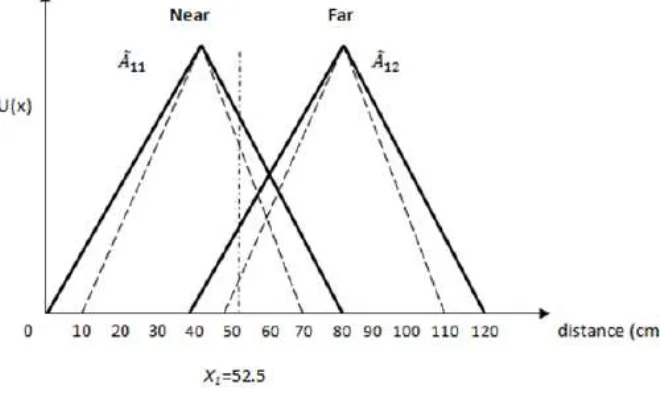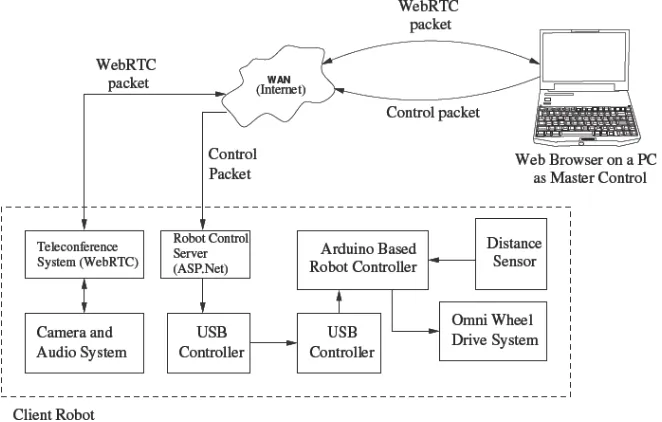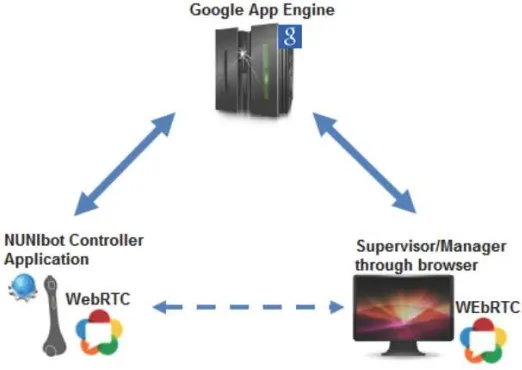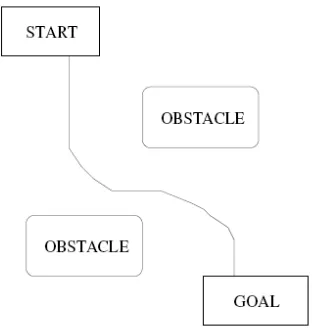Volume8, Number3(tentative), March2014 pp.1–ICICIC2013-866
OBSTACLES AVOIDANCE FOR INTELLIGENT TELEPRESENCE ROBOT USING INTERVAL TYPE-2 FLC
Widodo Budiharto1, Bayu Kanigoro1, Margaretha Ohyver1
Muhsin Shodiq1, Cecilia Nugraheni2, Resmana Lim3
and Hendi Wicaksono4
1
School of Computer Science Bina Nusantara University
Jl. K. H. Syahdan No. 9, Palmerah, Jakarta 11480, Indonesia {wbudiharto; bkanigoro; mohyver; muhsin}@binus.edu
2
Information Technology Department Parahyangan University
Bandung, Indonesia [email protected]
3
Electrical Engineering Department Petra Christian University
Siwalankerto 121-131, Surabaya, Indonesia [email protected]
4
Electrical Engineering Department Surabaya University
Jl. Ngagel Jaya Selatan 169, Surabaya 60284, Jawa Timur, Indonesia [email protected]
Received May 2013; accepted July 2013
Abstract. Intelligent Telepresence robot is a new trend for communication remotely today, and obstacles avoidance for robot is one of the important research areas. This re-search reports and presents obstacles avoidance method for intelligent telepresence robot, a custom-build robot system specifically designed for teleconference with multiple people. We propose an interval type-2 FLC (Fuzzy Logic Controller) that is able to handle uncer-tainties for measuring distance of obstacle to navigate the robot. The robot is controlled using computer networks, so the manager/supervisor at office/industry can direct the robot to the intended person to start a discussion/inspection. We build a web application for controlling the multi-client telepresence robot and open-source video conference sys-tem. Experimental result shows the ability of robot to be controlled remotely and to avoid obstacles smoothly and we evaluated its performance.
Keywords: Telepresence robot, Interval type-2 FLC, Obstacle avoidance
1. Introduction. Interval Type-2 Fuzzy Logic Controller is a controller that is ideal for navigation of the telepresence robot because it is able to handle the uncertainties. The idea of a telepresence robot stems from the inherent limitations imposed by traditional video conferencing systems, in which interaction is restricted to the meeting room only. Telepresence robots are already being used in hospitals to allow doctors and specialists to give consultations from afar. T. B. Sheridan shows that progress in robotics depends not only on the change in technology, but also on advances in humans relationships to machines. He said that human supervisory control has the potential to bring robotics out of the laboratory and into the difficult and messy world [13]. Traditionally, telepresence robots can also be used to give people with restricted mobility a new way to outreach and interact beyond their usual living quarters [3, 10, 12]. In office or factory, some-times manager/supervisor wants to discuss/supervise staffs remotely. So, based on that
situation, telepresence robot with capability of multi-client can be used on that scenario. An assisted teleoperation feature for a Mobile Remote Presence (MRP) system focusing on both the system-oriented dimensions (e.g., autonomous assistance vs. no assistance) and human-oriented dimensions (e.g., gaming experience, locus of control, and spatial cognitive abilities) (N = 24) have been developed [8]. Another research developed a telepresence mobile robot controlled with a noninvasive brain-computer interface to pro-vide a user with presence in remote environments through a mobile robot, with access to the internet [2]. However, so far there is no model for telepresence robot using interval type-2 FLC and web based application framework. State of the art of this research is to propose the Interval Type-2 Fuzzy Logic Controller for obstacles avoidance and web user interface that will be used for telepresence robot named as NUNI. This robot can be used in office/factory with the video conferencing features using WebRTC for controlling the robots on the web and fast movement using omniwheel mechanism.
This paper reports the complete results of the investigation and is organized as follows: Section 2 describes the design of an intelligent telepresence technology, Section 3 describes the experimental results and discussion, and conclusions are drawn in Section 4.
2. Design of the System.
[image:2.595.124.475.564.643.2]2.1. Interval type-2 fuzzy logic controller. Fuzzy logic systems (FLS) have been used in different applications with satisfactory performance [9]. The human perception cannot be modeled by traditional mathematical techniques; thus, the introduction of fuzzy set (FS) theory in this modeling has been suitable. Real-world applications are treated, and many sources of uncertainty often appear. Several natures of uncertainties would influ-ence the performance of a system. Type-2 fuzzy logic systems (T2-FLS) make possible to model and handle uncertainties. These are rule based systems in which linguistic vari-ables are described by means of Type-2 fuzzy sets (T2-FSs) that include a footprint of uncertainty (FOU). It provides a measure of dispersion to capture more about uncertain-ties. While T2-FSs have non-crisp MFs, T1-FSs have crisp membership grades (MGs). A representation of the inference model for T2-FLS is depicted in Figure 1 [11]. It begins with fuzzification, which maps crisp points into T2-FSs. Next, inference engine computes the rule base by making logical combinations of antecedent T2-FS, whose results are im-plicated with consequent T2-FS to form an aggregated output type-2 fuzzy set. Interval type-2 fuzzy logic, a special case of type-2 fuzzy system, is currently the most widely used for their reduced computational cost.
Figure 1. Type-2 fuzzy logic systems [6]
An Interval Type-2 Fuzzy Set is one in which the membership grade of every domain point is a crisp set whose domain is some interval contained in [0,1]. Consider the rule base of an IT2 FLS consisting of N rules assuming the following form:
Rn : IFx1 is ˜X1n and . . . and xI is ˜XIn, THENy isY n n
= 1,2, . . . , N (1) where ˜Xn
i (i = 1,2, . . . , I) are IT2 FSs, and Yn = [yn, yn] is an interval. Assume the
input vector is x′(x′
1, x′2, . . . , x′I) then the computation in an interval IT2 FLS involves the
1. Compute the membership of x′
i on each:
Xin,[µXn i(x
′
i), µXni(x ′
i)], i= 1,2, . . . , I; n= 1,2, . . . , N (2)
whereµXn i(x
′
i) are the upper membership functions, andµXni(x ′
i) are the lower
mem-bership functions.
2. Compute the firing interval of the nth rule, Fn(x′
):
Fn(x′
) = [µXn i(x
′
i)×L×µXn i(x
′
i), µXni(x ′
i)×L×µXni(x ′
i)]≡[f n, f
n], n= 1, ..., N (3)
where fn and fn are the lower and upper firing intervals. 3. Perform type-reduction to combine Fn(x′
) and the corresponding rule consequents using center-of-sets-reducer:
Ycos(x′
) = ∪
fn ∈Fn
(x′)
yn ∈Yn
N ∑ n=1
fnyn
N ∑ n=1
fn
(4)
ylandyrcan be computed using Karnik-Mendel Algorithms (KMA). It is an iterative
and computationally intensive algorithm. The main idea of KMA is to find the switch points for yl and yr.
4. Compute the defuzzified output as:
y= yl+yr
2 (5)
The model of interval Type-2 Fuzzy Logic for navigation of robot is depicted in Figure 2 in which a distance between robot and obstacles was measured using three ultrasonic distance sensors [4, 5].
[image:3.595.134.464.567.766.2]The NUNI Telepresence robot had been designed to have some features in mind. Some of the features are first driving in any direction capability, second using stereo camera to track a person and avoiding obstacle supported by three ultrasonic sensors, and third tele-conferencing system which employed one camera pointed forward to a person, microphone and speaker. To be capable of driving in any direction, especially in closed and limited room space, the robot employed holonomic or omni-directional three wheel configuration. The stereo camera placed on the robot has some functions which are object detection, depth estimation, and face tracking system. Multiple obstacle avoidance of the robot
Figure 3. Visual perception model for NUNI telepresence robot using Mi-noru 3D stereo camera
Figure 4. Interconnecting robot client to server through networks
employed a stereo camera with Kalman Filter from previous work [1]. Face tracking of the robot based of visual-perception model is depicted in Figure 3. The concept showed that an image pre-processing was used to filter the noise after image aquisition step then the feature extraction had recognized a person in which a command was issued to robot controller to follow the person [1].
The system architecture of the NUNI Telepresence robot is shown in Figure 4. It has two servers, Teleconference System and Robot Control Server, between Master Control and the robot. Teleconference System uses Google WebRTC as its service and ASP.Net is used for Robot Control Server to serve incoming control packet from Master Control. Figure 4 shows Camera and Audio system send their image and sound streams through Google WebRTC into Internet and Master Control receives them from it. Other important part in Figure 4 is Robot Control Server which gives capability of the robot to be controlled from Master Control by sending messages to it. The part’s messages consist of four instructions which are forward, backward, left and right. When the controller receives the messages from Master Controller through Internet, it passes through the messages to Arduino Based Robot Controller using USB interfaces. The Arduino Based Robot Controller translates the messages to Pulse Width Modulation (PWM) then sends it to the motors. Besides the messages, the controller receives messages from Distance Sensor part shown in Figure 4 to measure between the robot and an obstacle.
[image:4.595.134.465.234.445.2]Figure 5. Current system of intelligent telepresence robot
Arduino Microcontroller with IO Expansion Board as its controller, second it has three wheels driving with omni wheel that gives capability of rotation, and third it has ultrasonic sensors and fall detection sensors as distance measurement and balancer respectively. Its dimension is 363mm×363mm×140mm and its body material is made from aluminum alloy which is quite good for holding average laptop computer and a 14′′
LCD monitor. A DC-to-AC inverter was needed to power 14′′
monitor from 12V dry battery. The monitor and the camera, which were installed on the monitor, were placed at an aluminum bracket with one meter aluminum arm mounted on the base. A wireless router was needed to communicate between the robot and Master Controller to simulate WAN part on Figure 4. The overral height of the robot is 130cm which allows for natural conversation with a person while standing or being seated.
The test was conducted by running Microsoft IIS and Google Application Engine first on the laptop. When the servers were ready, Master Controller, implemented by using a laptop, opened the application through web browser that supported WebRTC and entered 192.168.1.101 which was the address of both servers to open it. This is not a problem because the servers were running on different ports. After the connections were established, Master controller then received image and sound stream from the robot and sent back image and sound from Master Controller web camera to the robot which means teleconference on Figure 4 is ready as shown in Figure 6(a).
Experiments of intelligent telepresence robot had been tested by navigating the robot to staff person and to avoid obstacles in the office. Face tracking and recognition based on eigenspaces with 3 images of each person had been used and a database of the images had been developed [14]. Based on the experiment, the system was running very well with the capability to avoid obstacles, recognise people and face tracking. The robot was controlled using integrated web application (ASP.Net and WebRTC) from Master Control. With a high speed Internet connection, simulated using wireless router that had speed around 1 Mbps, the result of video conferencing was noticeable smooth, as shown in Figure 6. Other result was obstacle avoidance using Interval Type-2 fuzzy logic controller depicted in Figure 7. The time efficiency in Table 1 shows that interval type-2 FLS is more efficient than other methods.
Figure 6. Web based application using WebRTC for teleconference system 6(a) and teleconference with a client using intelligent telepresence robot 6(b)
Figure 7. The path generated by robot to avoid obstacles using interval type-2 fuzzy logic controller
Table 1. Comparison for time efficiency between fuzzy logic and interval type-2 FLS running based on Figure 7
No Fuzzy Logic Interval Type-2 FLC
1 12.0s 10.5s
2 6.5s 5.5s
3 4s 4s
as the image. The Master Computer receives the image and sound from the robot then an operator can hear and watch an image. A distance between the robot and the person is determined by distance sensor located in the base of the robot. Figure 7 depicted the path generated by the robot to avoid obstacles based on the Type-2 Fuzzy Logic Controller then we conclude that this controller can successfully navigate the robot smoothly.
[image:6.595.190.405.589.648.2]REFERENCES
[1] W. Budiharto, D. Purwanto and A. Jazidie, A navigation system for service robot using stereo vision and Kalman filtering,Proc. of the 11th IEEE International Conference on Control, Automation and Systems, pp.1771-1776, 2011.
[2] C. Escolano et al., A telepresence mobile robot controlled with a noninvasive bracomputer in-terface, IEEE Transactions on Systems, Man, and Cybernetics, Part B: Cybernetics, vol.42, no.3, pp.793-804, 2012.
[3] D. A. Lazewatsky and W. D. Smart, An inexpensive robot platform for teleoperation and exper-imentation, Proc. of the IEEE International Conference on Robotics and Automation, Shanghai, pp.1211-1216, 2011.
[4] H. Hagras, A type-2 fuzzy logic controller for autonomous mobile robots, Proc. of the 2004 IEEE International Conference on Fuzzy Systems, FUZZ-IEEE, Budapest, Hungary, 2004.
[5] H. Hagras, Type-2 FLCs: A new generation of fuzzy controllers, IEEE Computational Intelligence Magazine, pp.30-43, 2007.
[6] J. Mendel, Advances in type-2 fuzzy sets and systems,Information Sciences, pp.84-110, 2007. [7] J. M. Mendel, Uncertain Rule-Based Fuzzy Logic Systems: Introduction and New Directions, Upper
Saddle River, Prentice-Hall, NJ, 2001.
[8] L. Takayama, E. Marder-Eppstein, H. Harris and J. M. Beer, Assisted driving of a mobile remote presence system: System design and controlled user evaluation, Proc. of the IEEE International Conference on Robotics and Automation, Shanghai, pp.1883-1889, 2011.
[9] L. X. Wang,A Course in Fuzzy Systems and Control, Prentice Hall, New Jersey, 1997.
[10] M. Quigley, B. Gerkey, K. Conley, J. Faust, T. Foote et al., ROS: An open-source robot operating system, Proc. of the Open-Source Software Workshop at the International Conference on Robotics and Automation, pp.6, 2009.
[11] O. Castilo,Type-2 Fuzzy Logic: Theory and Applications (Studies in Fuzziness and Soft Computing), Springer Publisher, 2012.
[12] S. Alers, D. Bloembergen, D. Hennes and K. Tuyls, Augmented mobile telepresence with assisted control,Proc. of the 23rd Benelux Conference on Artificial Intelligence, 2011.
[13] T. B. Sheridan,Telerobotics, Automation and Human Supervisory Control, 1st Edition, MIT Press, 1992.
[14] W. Budiharto, B. Kanigoro, M. Shodiq and Hutomo, The framework of intelligent telepresence robot based on stereo vision,Journal of Computer Science, vol.8, no.12, 2012.
[15] W. Budiharto, D. Santoso and A. Jazidie, A robust obstacle avoidance for service robot using Bayesian approach,International Journal Advanced Robotic System, vol.8, pp.37-44, 2011.
[16] http://www.webrtc.org/.
![Figure 1. Type-2 fuzzy logic systems [6]](https://thumb-ap.123doks.com/thumbv2/123dok/573465.547963/2.595.124.475.564.643/figure-type-fuzzy-logic-systems.webp)



